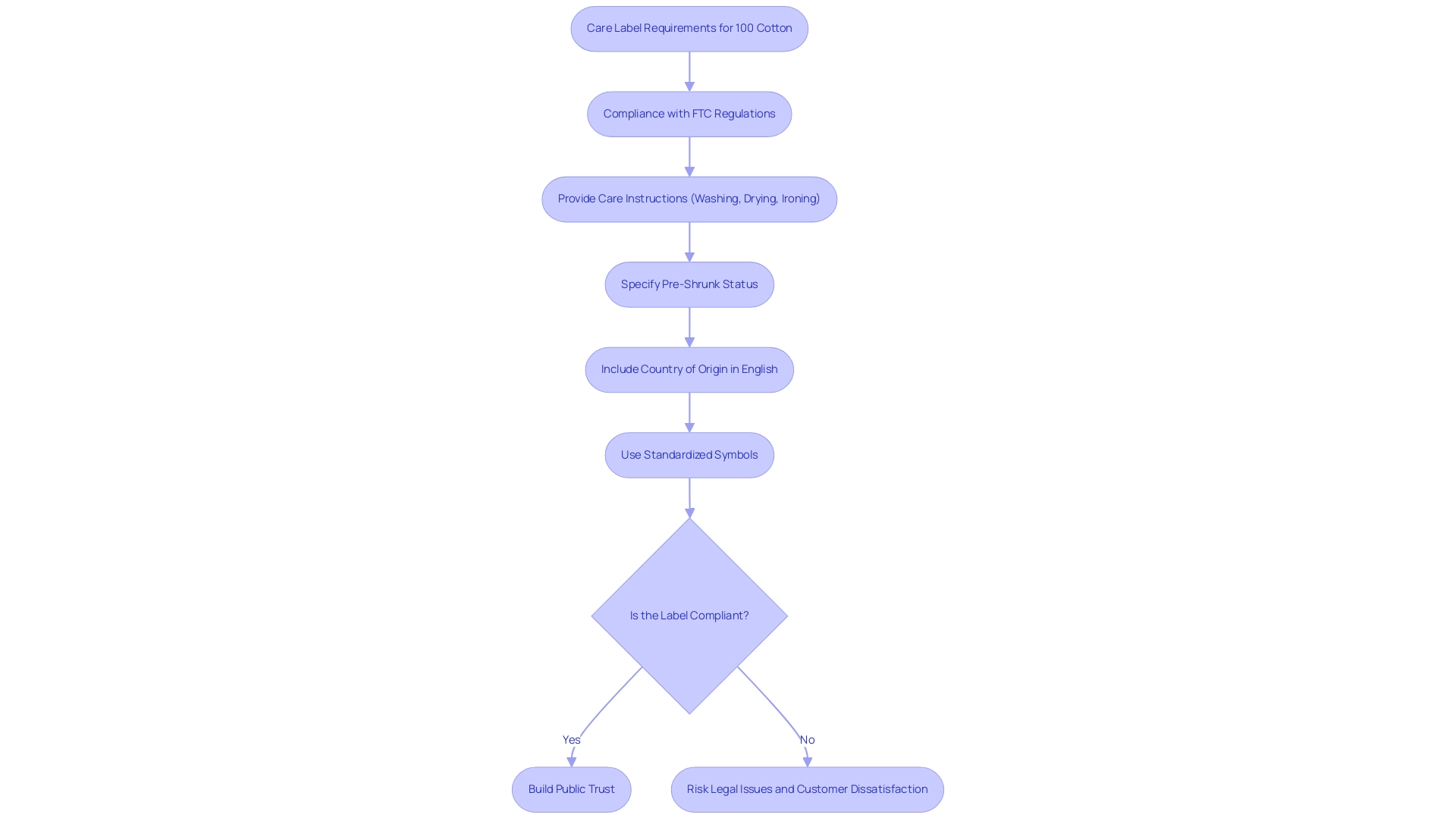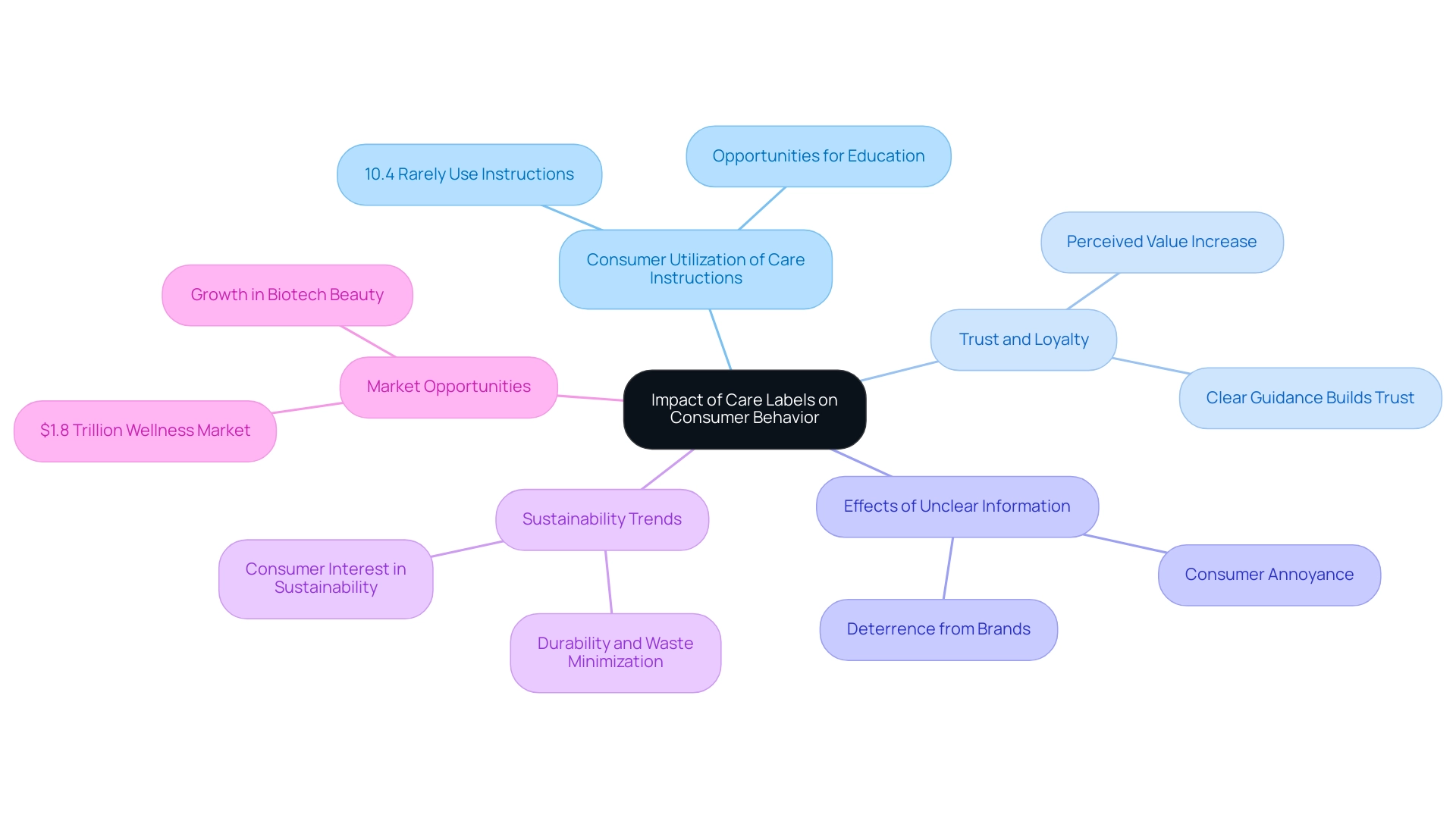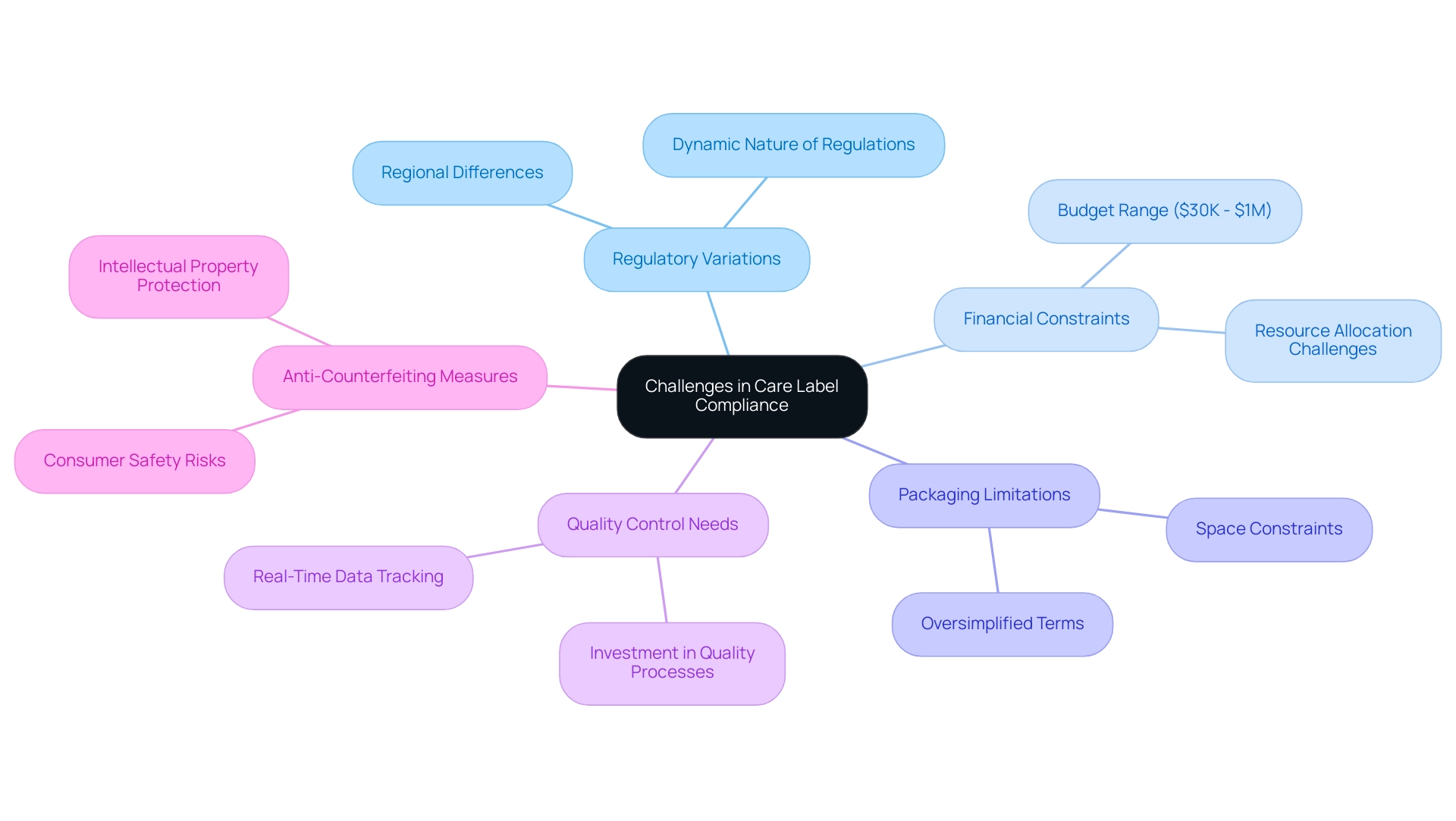What Are Care Labels for 100% Cotton? Understanding Their Importance and Requirements
Learn the significance of care label 100 cotton in maintaining garment quality and consumer satisfaction.

Overview:
Care labels for 100% cotton are essential as they provide critical care instructions that enhance garment durability, customer satisfaction, and compliance with legal requirements. The article emphasizes that clear and informative care labels not only help consumers maintain their clothing effectively but also foster trust and loyalty, while noncompliance can lead to customer dissatisfaction and potential legal issues for manufacturers.
Key Highlights:
- Care labels provide essential guidance for washing, drying, and maintaining cotton garments, impacting their durability and aesthetic appeal.
- A significant portion of consumers (41%) underestimate the ecological effects of cotton production, indicating a need for better education on garment maintenance.
- 25.38% of buyers consider carbon and greenhouse gas emissions in their purchasing decisions, linking care labels to environmental sustainability.
- Proper care of cotton garments enhances customer satisfaction and loyalty by maintaining fabric quality.
- Regulations require care labels to provide clear instructions on garment care, including washing and drying methods, and must state the country of origin.
- Noncompliance with care label regulations can lead to customer dissatisfaction and legal issues for manufacturers.
- 10.4% of consumers rarely use care instruction information, highlighting opportunities for brands to improve public education.
- Clear labeling can foster consumer trust and loyalty, while unclear information can deter purchases.
- Companies face challenges in balancing comprehensive care instructions with packaging space limitations, leading to potential consumer confusion.
- Investing in quality control and compliance management is essential for brands to meet legal standards and customer expectations.
Introduction
In the realm of fashion, care labels serve as the unsung heroes, guiding consumers in the proper maintenance of their garments, especially those crafted from 100% cotton. These labels not only provide crucial instructions for washing, drying, and ironing but also play an essential role in preserving the longevity and aesthetic appeal of the fabric.
As consumer awareness grows around the environmental implications of cotton production, the significance of clear and effective care labels becomes increasingly evident. They empower consumers to make informed choices, while also ensuring that manufacturers meet quality standards.
With a landscape marked by evolving regulations and a growing emphasis on sustainability, the importance of these labels extends beyond mere compliance; they are pivotal in fostering brand loyalty and enhancing customer satisfaction.
This article delves into the multifaceted role of care labels, exploring their impact on consumer behavior, the challenges brands face in compliance, and the essential guidelines that govern their use in the cotton garment industry.
The Essential Role of Care Labels in Cotton Garments
Instruction tags, including the care label 100 cotton, are crucial for buyers, providing vital advice on the appropriate handling and upkeep of clothing. These tags provide guidance on washing, drying, ironing, and other maintenance methods, all of which play a crucial role in preserving the fabric’s durability and aesthetic appeal. Studies show that 41% of people undervalue the ecological effects of cotton manufacturing, highlighting a wider pattern of public misconception about garment maintenance.
This gap highlights the significance of clear and informative product tags, which not only enable buyers to make informed choices but also guarantee that producers comply with quality standards. Furthermore, a notable 25.38% of buyers take into account carbon and greenhouse gas emissions when making purchasing choices, emphasizing the environmental factors related to cotton production and maintenance tags. Furthermore, correlation analysis indicates that consumers exhibit a readiness to spend more on organic and domestically produced items, highlighting the importance of guidance tags in encouraging sustainable practices.
When cotton garments are cared for properly, they maintain their softness, color, and shape, which in turn enhances customer satisfaction and fosters loyalty. As Tammi S. Feltham aptly noted,
Do not dry clean can be used with the do not wash symbol... do they have do not wear?
This emphasizes the necessity for guidance tags to be both informative and intuitive, ensuring that symbols are directly connected to their meanings.
By prioritizing effective care label 100 cotton instructions, brands can significantly impact garment durability and customer satisfaction, ultimately leading to a more sustainable approach to fashion.

Understanding Care Label Requirements for 100% Cotton
The care label 100 cotton provides specific care instructions for 100% cotton clothing, which are subject to regulations that can vary by region within the United States. The Federal Trade Commission (FTC) mandates that these tags must provide unambiguous instructions regarding washing, drying, and ironing methods. Additionally, the country of origin must be provided in English, which is crucial for compliance.
It is essential for tags to specify whether the cotton is pre-shrunk, as this significantly influences the garment's maintenance requirements. To enhance public comprehension, the symbols utilized on product tags must conform to standardization practices, ensuring clarity across diverse demographics and language obstacles. As James A. Kohm, Associate Director of the Division of Enforcement, stated in a letter, adherence to these regulations is not just a legal requirement for manufacturers; it is also a crucial aspect of building public trust and ensuring the perceived quality of the product.
Furthermore, the case study titled 'Mechanics of Labeling' illustrates how amendments to the Textile and Wool Acts streamline labeling requirements for textile products, emphasizing the importance of clear and accessible disclosures. Noncompliance can lead to customer dissatisfaction and expose companies to possible legal issues, emphasizing the significance of careful adherence to FTC requirements for product tags.

The Impact of Care Labels on Consumer Behavior
Care instructions play a crucial role in shaping buyer behavior, providing vital information that directly impacts purchasing choices. Studies show that a notable 10.4% of participants 'never' or 'almost never' utilize instruction information when maintaining clothing, highlighting a significant opportunity for companies to improve public education on this essential aspect. Brands that offer clear and detailed guidance not only cultivate greater trust among buyers but also elevate the perceived worth of their products, ultimately resulting in heightened customer loyalty.
On the other hand, unclear or missing product information can lead to annoyance, deterring buyers from interacting with brands that lack transparency. As the United Nations emphasizes in their quote on 'Ageing,' purchasing behavior is increasingly influenced by the clarity and relevance of product information. Moreover, the case study on skin problems noted in a uranium-processing facility demonstrates the practical implications of guidance labels; improper handling can result in considerable health concerns, emphasizing the necessity of clear instructions.
As sustainability gains greater importance, buyers are more inclined to connect with companies that provide maintenance guidelines encouraging product durability and waste minimization. This trend is further supported by the significant opportunities in the $1.8 trillion global wellness market, where there is a rising interest in data- and science-backed health and wellness solutions. Efficient product labeling arises as a crucial approach in contemporary company development, especially as public awareness of sustainable practices keeps increasing.
By implementing clear and informative labeling strategies, companies can significantly enhance their relationship with consumers and affect purchasing choices in 2024 and beyond.

Challenges in Care Label Compliance for Brands
Navigating care label compliance presents a myriad of challenges for companies, particularly in an ever-evolving regulatory landscape that varies by region. This dynamic nature of regulations demands significant resources, which can be especially burdensome for smaller companies with limited staff and budgets. The available budget for marketing activities can range from $30K to $1M, illustrating the financial constraints faced by smaller companies as they attempt to keep up with legislative changes while managing the operational demands of their business.
Furthermore, companies must find a delicate equilibrium between offering thorough usage guidelines and conforming to the physical limitations of packaging space. This frequently leads to oversimplified terms that can result in consumer confusion and dissatisfaction. Guaranteeing that maintenance tags precisely represent the actual requirements of garments is crucial; inaccuracies can lead to poor customer experiences, which ultimately affect loyalty to the company.
Furthermore, manufacturers are increasingly recognizing the need to invest in quality control processes to ensure that their products not only meet legal standards but also align with customer expectations. OpsNinja's modern quality control platform stands out in this regard, offering features such as real-time data tracking and automated reporting capabilities that enhance data connectivity and transparency, ultimately addressing the lack of real-time visibility in supply chains. As noted by industry experts, "common challenges arising as a result include inefficiencies in organizing, processing, and managing data; limited availability of useful insights due to technological constraints; and a lack of synergy between automated systems and manual operations."
In 2024, the challenges related to compliance with product instructions are anticipated to increase, requiring proactive strategies from companies. As counterfeit products pose risks to consumer safety and infringe on manufacturers' intellectual property, investing in anti-counterfeiting measures becomes a critical component of compliance strategies. By leveraging OpsNinja's tailored approach and dedicated quality support team, companies can navigate the complexities of care label 100 cotton regulations more effectively, fostering greater trust with their customers.
The dedicated quality team not only assists with compliance management but also ensures that brands receive the support they need to thrive in a competitive market. For example, increasing visibility and transparency in supply chains can benefit all stakeholders, as evidenced by case studies demonstrating the importance of real-time updates in compliance tracking. Get started with OpsNinja today and experience the difference our dedicated support can make in your quality control processes.

Conclusion
Understanding the essential role of care labels in cotton garments reveals their significant impact on consumer behavior, brand loyalty, and sustainability efforts. These labels not only provide crucial instructions for garment maintenance but also empower consumers to make informed decisions, thereby enhancing customer satisfaction. Clear and effective care labels are vital in bridging the knowledge gap surrounding the environmental implications of cotton production, as many consumers remain unaware of the ecological footprint associated with their purchases.
The regulatory landscape governing care labels poses challenges for brands, particularly smaller ones with limited resources. Adhering to compliance requirements while ensuring that labels are informative and user-friendly is crucial for fostering consumer trust. Moreover, the willingness of consumers to pay a premium for sustainably produced products underscores the potential for brands to differentiate themselves through effective labeling strategies.
As the fashion industry continues to evolve, prioritizing clear and comprehensive care labels will not only promote garment longevity but also align brands with the growing consumer demand for sustainability. By investing in quality control and compliance management, brands can navigate the complexities of labeling while cultivating deeper connections with their customers. The future of fashion relies on transparency and education, and care labels stand at the forefront of this critical movement.



